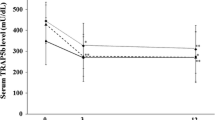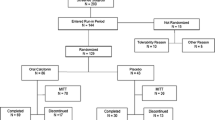Abstract:
Thirty postmenopausal women with reduced bone mineral density were divided randomly into two groups based on the chronological sequence of their first visit to the Osteoporosis Clinic of Katsuragi Hospital. Group I was given 600 mg ipriflavone orally daily and group II was weekly injected intramuscularly with 20 units elcatonin, Asu1–7 eel calcitonin (carbocalcitonin). Lumbar spine BMD was measured by dual-energy X-ray absorptiometry, and trabecular bone mineral density at the distal radius, cortical bone density, and relative cortical volume at the radial diaphysis by peripheral computed tomography before the beginning of the study and at the 4th, 8th, and 12th month. Markers of bone metabolism—serum total alkaline phosphatase, bone-specific alkaline phosphatase, tartrate-resistant acid phosphatase, osteocalcin, intact osteocalcin, PICP and ICTP, and urinary pyridinoline, deoxypyridinoline, and calcium/creatinine (Ca/Cr)—were also measured at the same interval. Plasma parathyroid hormone (PTH) and calcitonin (CT) were measured at the same time. Radial trabecular bone density showed a significantly higher rate of increase in group I (ipriflavone group) than in group II (elcatonin group) at the 4th month, whereas lumbar spine BMD showed more pronounced increase in the elcatonin group than in the ipriflavone group throughout the study period. Bone metabolism markers tended to decline in both groups. Total and intact osteocalcin showed a significant fall from the baseline throughout the study period only in the ipriflavone group. Urine pyridinoline and deoxypyridinoline showed a significant fall from the baseline at the 12th month only in the ipriflavone group. On comparing bone gainers with increase of lumbar spine BMD by 2% or more with bone losers with a decrease by 2% or more, only urine Ca/Cr was significantly different, lower in the former than in the latter, despite the general tendency for bone resorption markers to decrease in bone gainers and to increase in bone losers.
Similar content being viewed by others
Author information
Authors and Affiliations
Additional information
Received: Jan. 13, 1999 / Accepted: Feb. 26, 1999
About this article
Cite this article
Fujita, T., Fujii, Y., Miyauchi, A. et al. Comparison of antiresorptive activities of ipriflavone, an isoflavone derivative, and elcatonin, an eel carbocalcitonin. J Bone Miner Metab 17, 289–295 (1999). https://doi.org/10.1007/s007740050097
Issue Date:
DOI: https://doi.org/10.1007/s007740050097




